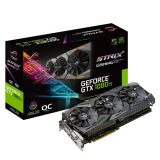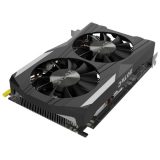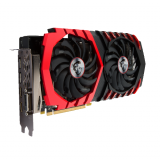 If you’re a gamer, then you know that every gaming PC absolutely needs a solid graphics card. That’s because no matter what other components are in your gaming rig, or how high-end they may be, it is really the graphics card that delivers all that sweet, sweet gaming goodness to your monitor. You may have a fast CPU, a schwack of RAM, and an infinite amount of storage on your hard drive, but without a good graphics card, you may as well be playing Pong on your computer. So, to help you buy, build or upgrade a PC that can positively chew up the jaw-dropping visuals and action of today’s pixel-intensive game titles, I’m going to run down the five best graphics cards for gaming this year.
If you’re a gamer, then you know that every gaming PC absolutely needs a solid graphics card. That’s because no matter what other components are in your gaming rig, or how high-end they may be, it is really the graphics card that delivers all that sweet, sweet gaming goodness to your monitor. You may have a fast CPU, a schwack of RAM, and an infinite amount of storage on your hard drive, but without a good graphics card, you may as well be playing Pong on your computer. So, to help you buy, build or upgrade a PC that can positively chew up the jaw-dropping visuals and action of today’s pixel-intensive game titles, I’m going to run down the five best graphics cards for gaming this year.
A Graphics Card Primer
Everything you see on your computer monitor is made up of tiny dots called pixels. At default settings, most common resolutions display more than a million pixels, and your computer has to figure out what to do with each and every pixel in order to create an image for you. To accomplish this, your computer needs something that takes the binary data (all those ones and zeros) from your CPU, and turn it into a visual representation. That’s where a graphics card comes in. Graphics cards feature dedicated video memory (VRAM) together with a graphics processing unit (GPU). The GPU handles calculations and mapping textures, while the VRAM acts as a high-speed memory pool for the GPU. Suffice it to say, you need to find the best graphics card for your budget if you want the absolute best gaming experience possible.
Graphic Card Companies
Today, you’ll find two major companies that sell graphic cards and are known to any gamer worth their salt – AMD and Nvidia. This pair of companies tend to create graphic cards that are targeted towards a variety of audiences, some are high-end, and some are built for those on a tighter budget. Additionally, graphic cards have different aftermarket partners who create graphic cards that perform and look different, but usie the original chips from both companies. This can cause a lot of confusion for consumers as to which cards perform best. You’ll find my top recommendations below, based on research, and perusing a ton of reviews and online rankings.
ROG Strix GeForce GTX 1080 Ti OC edition 11GB
 Asus’s ROG Strix GeForce GTX 1080 Ti OC edition with 11GB of memory is the company’s current flagship card. As with other 1080 Tis, this card was designed for 4K gaming, VR experiences and jaw-dropping visuals. It features a large 2.5 slot design, convenient one-click overclocking, two VR-Ready HDMI ports, two DP 1.4-ready connectors, a dual-link DVI output and case fan headers that sync your case’s cooling to the GPU, plus it has the Asus Aura Sync RGB lighting system. Reviews I’ve read say this high-end card runs really quietly, even under a full load, and it stays cool under intense graphics-producing pressure. But, be prepared to pay the price for such a wicked, high-end card.
Asus’s ROG Strix GeForce GTX 1080 Ti OC edition with 11GB of memory is the company’s current flagship card. As with other 1080 Tis, this card was designed for 4K gaming, VR experiences and jaw-dropping visuals. It features a large 2.5 slot design, convenient one-click overclocking, two VR-Ready HDMI ports, two DP 1.4-ready connectors, a dual-link DVI output and case fan headers that sync your case’s cooling to the GPU, plus it has the Asus Aura Sync RGB lighting system. Reviews I’ve read say this high-end card runs really quietly, even under a full load, and it stays cool under intense graphics-producing pressure. But, be prepared to pay the price for such a wicked, high-end card.
ZOTAC GeForce GTX1050 OC Edition 2GB GDDR5
 Powered by the powerful Pascal architecture, the dual-fan ZOTAC GeForce GTX 1050 OC Edition graphics card features 2GB of GDDR5 memory, a core clock speed of 1455MHz, a boost engine clock speed of 1569MHz, and a memory clock speed of 7GHz. It also has a DisplayPort, one HDMI, and one DL-DVI slot, so connecting to one or multiple monitors is easy as can be. This is a nice budget-friendly card, that delivers seamless and silky smooth graphics, plus it’s loaded with lots of Nvidia features and options, such as Nvidia Ansel, which lets you capture in-game screenshots, edit them, and share on your smart devices.
Powered by the powerful Pascal architecture, the dual-fan ZOTAC GeForce GTX 1050 OC Edition graphics card features 2GB of GDDR5 memory, a core clock speed of 1455MHz, a boost engine clock speed of 1569MHz, and a memory clock speed of 7GHz. It also has a DisplayPort, one HDMI, and one DL-DVI slot, so connecting to one or multiple monitors is easy as can be. This is a nice budget-friendly card, that delivers seamless and silky smooth graphics, plus it’s loaded with lots of Nvidia features and options, such as Nvidia Ansel, which lets you capture in-game screenshots, edit them, and share on your smart devices.
EVGA GeForce GTX 1080 FTW GAMING ACX 3.0
 The EVGA GeForce GTX 1080 FTW GAMING ACX 3.0 is another GTX 1080 card that is highly coveted by gamers. With 8GB of memory, this card is a lot cheaper than the Rog Strix, and features one dual link DVI-D connector, one HDMI 2.0b port and three full-sized DisplayPort 1.4 outputs. It’s fast, quiet, performs exceptionally well, and also sports a more moderate footprint than the ROG Strix, so it will fit better in cases with less space. Although, it would probably run a bit hot in a more constricted case, so just be aware of that fact.
The EVGA GeForce GTX 1080 FTW GAMING ACX 3.0 is another GTX 1080 card that is highly coveted by gamers. With 8GB of memory, this card is a lot cheaper than the Rog Strix, and features one dual link DVI-D connector, one HDMI 2.0b port and three full-sized DisplayPort 1.4 outputs. It’s fast, quiet, performs exceptionally well, and also sports a more moderate footprint than the ROG Strix, so it will fit better in cases with less space. Although, it would probably run a bit hot in a more constricted case, so just be aware of that fact.
MSI GeForce GTX 1070 TI Gaming 8G-PCI Express
The MSI GeForce GTX 1070 TI Gaming 8G-PCI Express was created to fill the performance gap between the GTX 1070 and GTX 1080 models. But, according to most reviews, this little baby actually comes very close to performing like a really nice 1080, in fact. Sporting 8GB of memory, this dual-slot card has a more conservatively clocked GPU, and low-noise cooler. It also only draws 180 watts of power. Performance-wise, the card is said to handle exceptionally well, able to handle 1440p games rather well, apparently.
MSI Radeon RX 580 GAMING X Dual Torx Fans 8GB
 The only AMD card on my list is the MSI Radeon RX 580 GAMING X Dual Torx Fans 8GB card. These cards are an updated and refreshed version of the RX 480 AMD cards, and can provide solid gaming experiences at 1080p with a frame rate of 60FPS. The card also offers Instant Performance Gain, meaning you can unlock extra performance or keep your computer quitter during light use with just one click. The card also has LED control, so you can customize your gaming LEDs. It also sports a HDMI and DVI outputs.
The only AMD card on my list is the MSI Radeon RX 580 GAMING X Dual Torx Fans 8GB card. These cards are an updated and refreshed version of the RX 480 AMD cards, and can provide solid gaming experiences at 1080p with a frame rate of 60FPS. The card also offers Instant Performance Gain, meaning you can unlock extra performance or keep your computer quitter during light use with just one click. The card also has LED control, so you can customize your gaming LEDs. It also sports a HDMI and DVI outputs.
So, what do you think of my choices for the five best gaming cards for the year? Is there a card you prefer that isn’t on my list? Let me know what you think in the comment section below, and don’t forget to check out all the graphics cards available at Best Buy.




The best 5 graphics card which is important for the user to know it fully in the embedded way and it is going to use it in further which will be the most important part for the user.
The GTX 1050 is one hell of a beast for its price. It can run pretty much everything at 1080P. Full HD gaming has never been this affordable before.
Comments are closed.